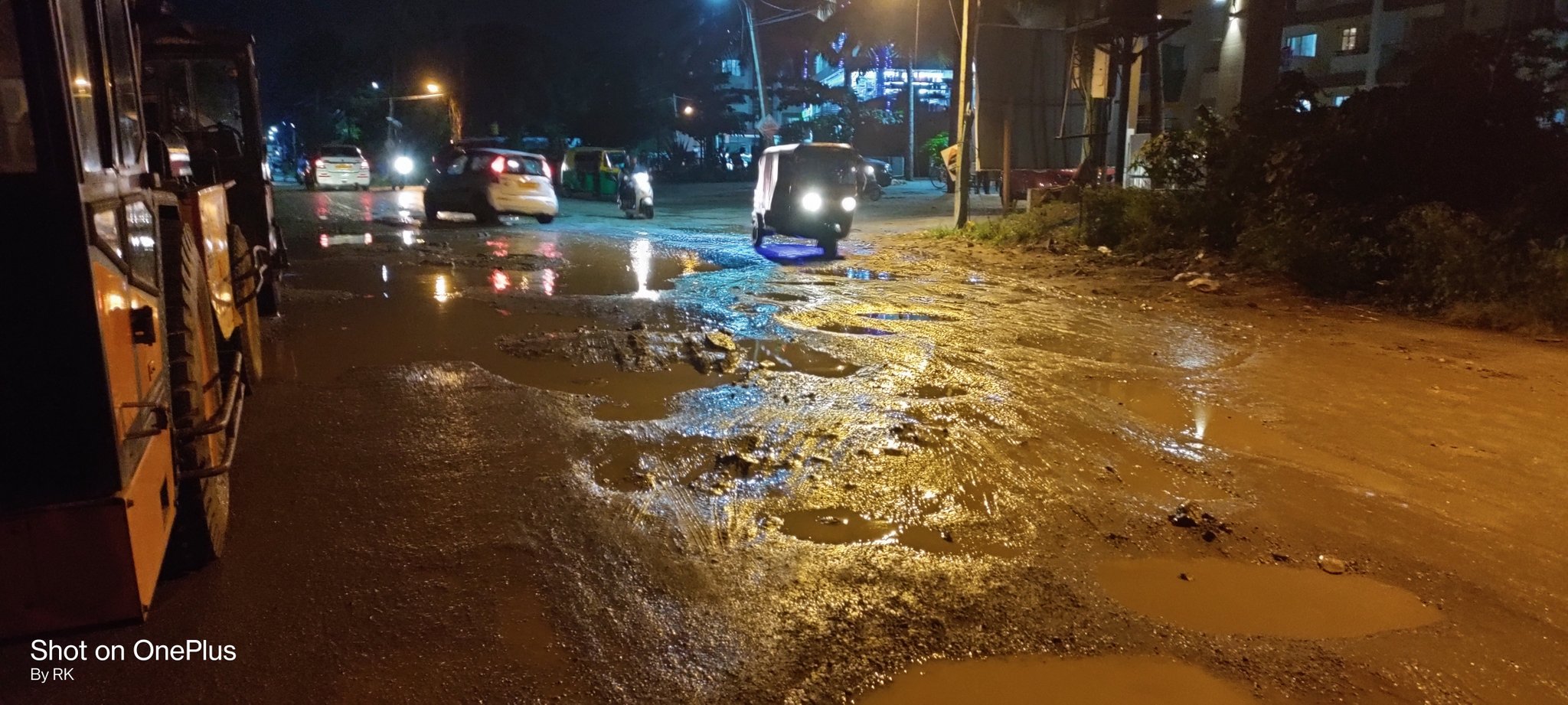Bengaluru Traffic Police have an additional task: Fix potholes at busy junctions as civic body focuses on city's major carriageways.

A potholed road in Bengaluru. The BBMP and police have different definitions of a pothole. (Supplied)
What is a pothole? The Bengaluru Traffic Police and the civic body have different definitions for the deadly chuckholes that have been claiming lives in the city.
The result: A huge variance in pothole count. ‘Fix My Street,’ a mobile application devised by the BBMP to help citizens connect with ward engineers and other officials concerned, has recorded more than double the potholes the civic body has counted.
The Bengaluru Traffic Police (BTP) has been using the app extensively for the past 15 days, recording, reporting, and often quick-fixing the potholes.
BTP sources told South First that their personnel documented more than 7,500 potholes over the past 15 days on ‘Fix My Street’ app. The BBMP, however, claimed that their database has only 3,500 potholes that have to be fixed.
The difference in the pothole count has left the traffic police baffled. “We doubt if the BBMP is considering some pothole-riddled roads with heavy vehicular traffic as roads,” a senior traffic police officer attached to the east traffic division wondered.
Joint Commissioner of Police (Traffic) BR Ravikanthe Gowda defined a pothole as “any uneven road surface that affects smooth movement of traffic.” The BTP has been reporting any such roads to the BBMP.
“The traffic police are unsure if the civic authority would acknowledge several of the potholes reported as one. Sometimes they fill a pothole documented on ‘Fix My Street’, but there will be another one a few yards away. They will not attend to it since it has not been documented in the app,” a senior police officer said.
For BBMP, “a pothole is a depression on a road, shaped like a half-cut clay pot,” a top official told South First.
“Almost all the roads have utility cables, water and sewerage pipelines underneath them. When it rains, the rainwater seeps in and creates patches of potholes which could be superficial — we term it deterioration — that require patch work. Deeper potholes require either concreting or digging and refilling with asphalt and bitumen,” the official added.
Incidentally, the Oxford Advanced Learner’s Dictionary has a simpler definition for a pothole: “a large rough hole in the surface of a road that is formed by traffic and bad weather.”
BBMP Commissioner Tushar Girinath, meanwhile, has been having a busy schedule, inspecting civil works and following up the status of repairing roads. Roads in the east and southeastern parts of the city have been worst hit by the recent torrential showers.
Floodwaters have damaged several roads, including major, arterial and sub-arterial in east and southeast Bengaluru. The delay in repairing roads even made the High Court of Karnataka pull up BBMP and directed the civic body to find a solution to potholes in a time-bound manner.
Around two weeks ago, the BBMP officials convened a meeting with the BTP, seeking the latter’s help in identifying potholes, and reporting it over the ‘Fix My Street’ app.
Police personnel regulating traffic at various junctions in the city, have also been tasked with looking for potholes, geo-tag and photograph and report them, along with their coordinates, over the BBMP’s mobile app.
Once reported, a work order would be generated and the executive engineer concerned would be alerted. The work order would be closed after fixing the issue.
Members of the public, too, document issues and alert the BBMP over ‘Fix My Street.’
“The BBMP has been creating around 10 login IDs daily for our police station in the west division. Our men are reporting somewhat 60 to 70 potholes daily. Our men are reporting somewhat 60 to 70 potholes daily,” Kuldeep Kumar Jain, Deputy Commissioner of Police (Traffic) West Division, said.
Within a week of the police taking up the additional charge of pothole search, around 3,500 potholes were identified and reported to the BBMP. The civic body, however, claimed that they had only 1,500 potholes that have to be fixed, and the works were being carried out simultaneously.
“The BBMP’s priority to fill potholes on major, arterial, and sub-arterial roads. They will focus on interior and other roads only after completing the works on the major carriageways,” a senior traffic police officer said.
Traffic police sources claimed that they had reported to BBMP 7,500 potholes over the past fortnight, but the civic body has been maintaining that only 3,500 have to be filled.
BBMP Commissioner Girinath explained the difference in the number of potholes. “Whenever potholes are reported, teams in the respective area under our engineers take up the works on a priority basis. Major roads, arterial, and sub-arterial roads are of high priority. We can attend to interior roads and gullies in a phased manner only after completing the works on these major carriageways,” he told South First.
Meanwhile, fed up with the civic authorities turning a blind eye to potholes at some busy traffic junctions and intersections, the traffic police personnel have been doubling up as road-maintenance workers.
Joint Commissioner of Police (Traffic) BR Ravikanthe Gowda told South First “We understand that it’s a herculean task for the BBMP. Hence our men are helping in fixing certain busy stretches,” Joint Commissioner Gowda told South First.

Jul 27, 2024

Jul 26, 2024

Jul 26, 2024

Jul 26, 2024

Jul 26, 2024

Jul 26, 2024